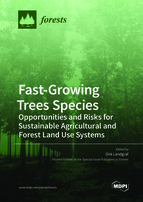Fast-Growing Trees Species—Opportunities and Risks for Sustainable Agricultural and Forest Land Use Systems
A special issue of Forests (ISSN 1999-4907). This special issue belongs to the section "Forest Ecology and Management".
Deadline for manuscript submissions: closed (31 January 2022) | Viewed by 25868
Special Issue Editor
Special Issue Information
Dear Colleagues,
Cultivation systems with fast-growing tree species are often discussed controversially in both science and practice. They are very diverse and pose opportunities as well as risks for land users and the surrounding ecosystems. Many different tree species and their varieties can be established on sites (usually) used for forestry; they can also be grown in short-rotation plantations (SRC) or in agroforestry systems (AFS) on agricultural soils. In most cases, the goals of the land users determine the choice of tree species and cultivation system, the rotation times, and their management. Thus, there is not only a large variety of management variants and technical and technological innovations, but also a large number of interactions with the surrounding ecosystems. In addition to the considerable effects on biodiversity in different landscapes, the tree–soil interactions also play an important role. For this reason, this Special Issue is intended to present new findings from science and practice in this broad field of fast-growing tree species cultivation in all its forms.
Prof. Dr. Dirk Landgraf
Guest Editor
Manuscript Submission Information
Manuscripts should be submitted online at www.mdpi.com by registering and logging in to this website. Once you are registered, click here to go to the submission form. Manuscripts can be submitted until the deadline. All submissions that pass pre-check are peer-reviewed. Accepted papers will be published continuously in the journal (as soon as accepted) and will be listed together on the special issue website. Research articles, review articles as well as short communications are invited. For planned papers, a title and short abstract (about 100 words) can be sent to the Editorial Office for announcement on this website.
Submitted manuscripts should not have been published previously, nor be under consideration for publication elsewhere (except conference proceedings papers). All manuscripts are thoroughly refereed through a single-blind peer-review process. A guide for authors and other relevant information for submission of manuscripts is available on the Instructions for Authors page. Forests is an international peer-reviewed open access monthly journal published by MDPI.
Please visit the Instructions for Authors page before submitting a manuscript. The Article Processing Charge (APC) for publication in this open access journal is 2600 CHF (Swiss Francs). Submitted papers should be well formatted and use good English. Authors may use MDPI's English editing service prior to publication or during author revisions.
Keywords
- Fast-growing tree species
- Ecosystem interactions
- Cultivation systems: SRC, agroforestry systems
- Management
- Growth results/biomass production
- Harvest and storage procedures
- Tree–soil interactions
- Phytosanitary situation in SRC






